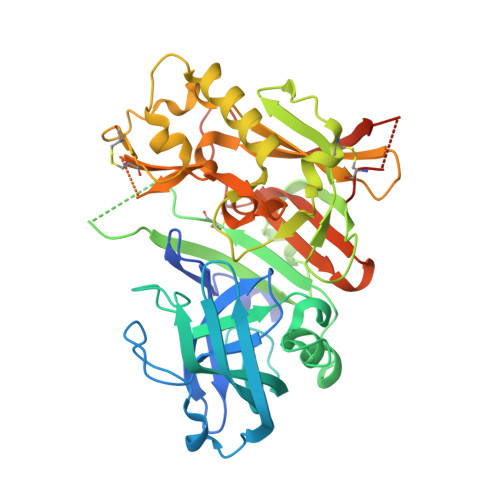New pyrazolyl and thienyl aminohydantoins as potent BACE1 inhibitors: Exploring the S2' region.
Malamas, M.S., Erdei, J., Gunawan, I., Barnes, K., Hui, Y., Johnson, M., Robichaud, A., Zhou, P., Yan, Y., Solvibile, W., Turner, J., Fan, K.Y., Chopra, R., Bard, J., Pangalos, M.N.(2011) Bioorg Med Chem Lett 21: 5164-5170
- PubMed: 21835615
- DOI: https://doi.org/10.1016/j.bmcl.2011.07.057
- Primary Citation of Related Structures:
3S7L, 3S7M - PubMed Abstract:
The proteolytic enzyme β-secretase (BACE1) plays a central role in the synthesis of the pathogenic β-amyloid in Alzheimer's disease. SAR studies of the S2' region of the BACE1 ligand binding pocket with pyrazolyl and thienyl P2' side chains are reported. These analogs exhibit low nanomolar potency for BACE1, and demonstrate >50- to 100-fold selectivity for the structurally related aspartyl proteases BACE2 and cathepsin D. Small groups attached at the nitrogen of the P2' pyrazolyl moiety, together with the P3 pyrimidine nucleus projecting into the S3 region of the binding pocket, are critical components to ligand's potency and selectivity. P2' thiophene side chain analogs are highly potent BACE1 inhibitors with excellent selectivity against cathepsin D, but only modest selectivity against BACE2. The cell-based activity of these new analogs tracked well with their increased molecular binding with EC(50) values of 0.07-0.2 μM in the ELISA assay for the most potent analogs.
- Pfizer Neuroscience Princeton, 865 Ridge Road, Monmouth Junction, NJ 08852, USA. malamas.michael@gmail.com
Organizational Affiliation:

















